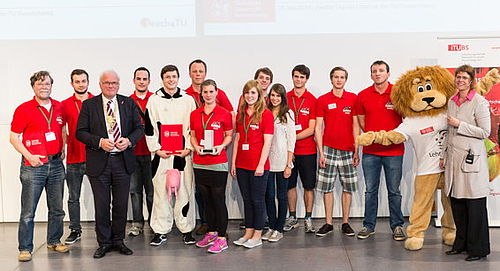
Award for good teaching from TUBS for our iGEM project and a Gold Medal in Boston for the team of Braunschweig students for their project to improve the world's climate.
As a result of the enhanced greenhouse effect the Earth’s climate is changing noticeably. Methane, a greenhouse gas like carbon dioxide (CO2), traps heat in the atmosphere increasing the global warming. However, it has to be kept in mind that the impact of methane on the greenhouse effect is 25-fold greater compared to CO2.
One of the several natural sources of methane is enteric fermentation in ruminants such as milk cows and cattle. In their rumen, billions of microorganisms release greenhouse gases as they help digesting the animal’s food. This is, in fact, a natural process, but industrial-scale farming and increasing demand intensify the emissions and thus the greenhouse effect. Although more and more people are willing to permanently do without dairy products and beef, the majority does not.
Methane can be utilized as a carbon source by methanotrophic bacteria, among them the model organism Methylococcus capsulatus. M. capsulatus uses the well-characterized soluble methane monooxygenase (sMMO), an enzyme complex consisting of three subunits, to convert methane to methanol.
Considering the huge impact of methane in comparison to CO2, methane emissions are a substantial point of action for future climate protection and thus gave us the idea for our project: We designed an engineered bacterium to metabolize methane right at its place of origin - the cow’s rumen.
During this iGEM season we were able to develop a technique to successfully express all components of the methane monooxygenase in E. coli in soluble form and we, furthermore, proved the activity of the complete enzyme complex. After construction and transformation of our final device and optimization of the cultivation conditions, we succeeded to produce one of the sMMO’s subunits, MMOC, in soluble form and another one, MMOX, in inclusion bodies. To achieve effective production of the remaining subunits in the soluble fraction we further analysed cotransformation of our engineered E. coli strain with different combinations of known chaperone proteins. Our findings suggest that the expression of the sMMO works best when coexpressed with the bacterial chaperones GroEL and GroES. For reasons of protection against bacteria-consuming ciliates in rumen fluid and thus to enable survival of E. cowli, we also tested entrapment and cultivation in alginate beads. Using a methane sensor we were also able to show degradation of methane by our engineered bacterium E. cowli.
To evaluate the efficiency of E. cowli in the natural environment of the cow’s rumen, we generated a mathematical model based on experimentally achieved and literature data. Hence, we figured out that as little as 50 $US per year is sufficient to reduce the annual methane emission by 110 kg per cow. Our mathematical model clearly indicates that a significant amount of methane can be degraded directly in the cow’s rumen when E. cowli is added to the feed. This implies that the greenhouse gas methane arising from enteric fermentation would no longer be released into the Earth’s atmosphere and could thus no longer contribute to the greenhouse effect. Future plans are to obtain purified sMMO in appropriate amounts to turn it into an industrially useful product. The new usability of the sMMO could conquer three major concerns of the industrialized economy: pollution, shortage of energy and of course global warming.
As the sMMO is able to degrade a broad variety of substrates such as one of the major water pollutants, the industrial solvent trichloroethylene (TCE), our project can serve as a foundation for a new approach of biological water treatment or environmental care in general.
One could also exploit the sMMO’s ability to convert methane to methanol: Methane can serve as a source of energy, but due to its gaseous state it is very difficult to transport compared to the liquid methanol. Up to now methane is chemically converted to methanol for transportation and later again chemically converted to components of diesel fuel and gasoline or to propylene and ethylene, precursors of important chemical substances. Using the sMMO to oxidize methane is a much more economical and eco-friendly approach to utilize methane as a resource for energy production.
Hence, our project has a huge significance regarding a wide-ranging spectrum of problems and opportunities.